Why Data Stewards Are Key to Governance Success
Data stewardship plays a pivotal role in ensuring your organization thrives in today’s data-driven world. By maintaining data accuracy, consistency, and reliability, data stewards empower you to make informed decisions and build trust in your data assets. They act as the bridge between IT and business, aligning data management with your goals. Without their expertise, poor data quality and regulatory non-compliance can jeopardize your operations. Data stewards also foster a culture of accountability, making them indispensable ingredients of data governance and organizational success.
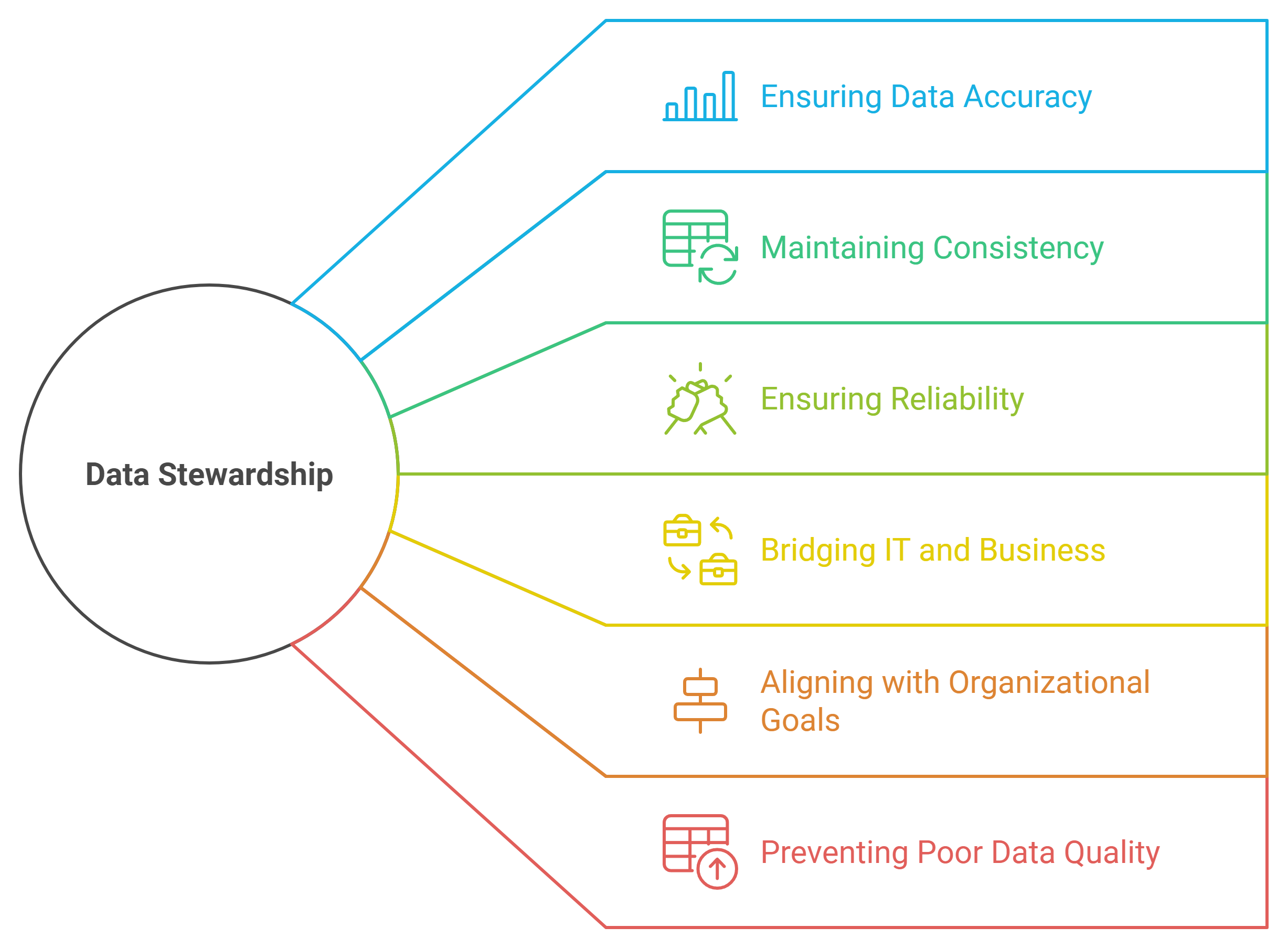
Key Takeaways
Data stewards are essential for maintaining data accuracy, consistency, and reliability, which are crucial for informed decision-making.
They act as a bridge between IT and business units, ensuring that data management aligns with organizational goals and fosters collaboration.
By enforcing data quality standards and monitoring compliance, data stewards help mitigate risks associated with poor data management.
Data stewards enhance data accessibility and usability, empowering teams to leverage data effectively for strategic initiatives.
Investing in strong data stewardship practices not only supports regulatory compliance but also builds trust with stakeholders.
Establishing clear roles and responsibilities for data stewards is vital for creating accountability and ensuring effective data governance.
Continuous training and resource provision for data stewards are key to maximizing their impact on organizational success.
Understanding Data Stewardship
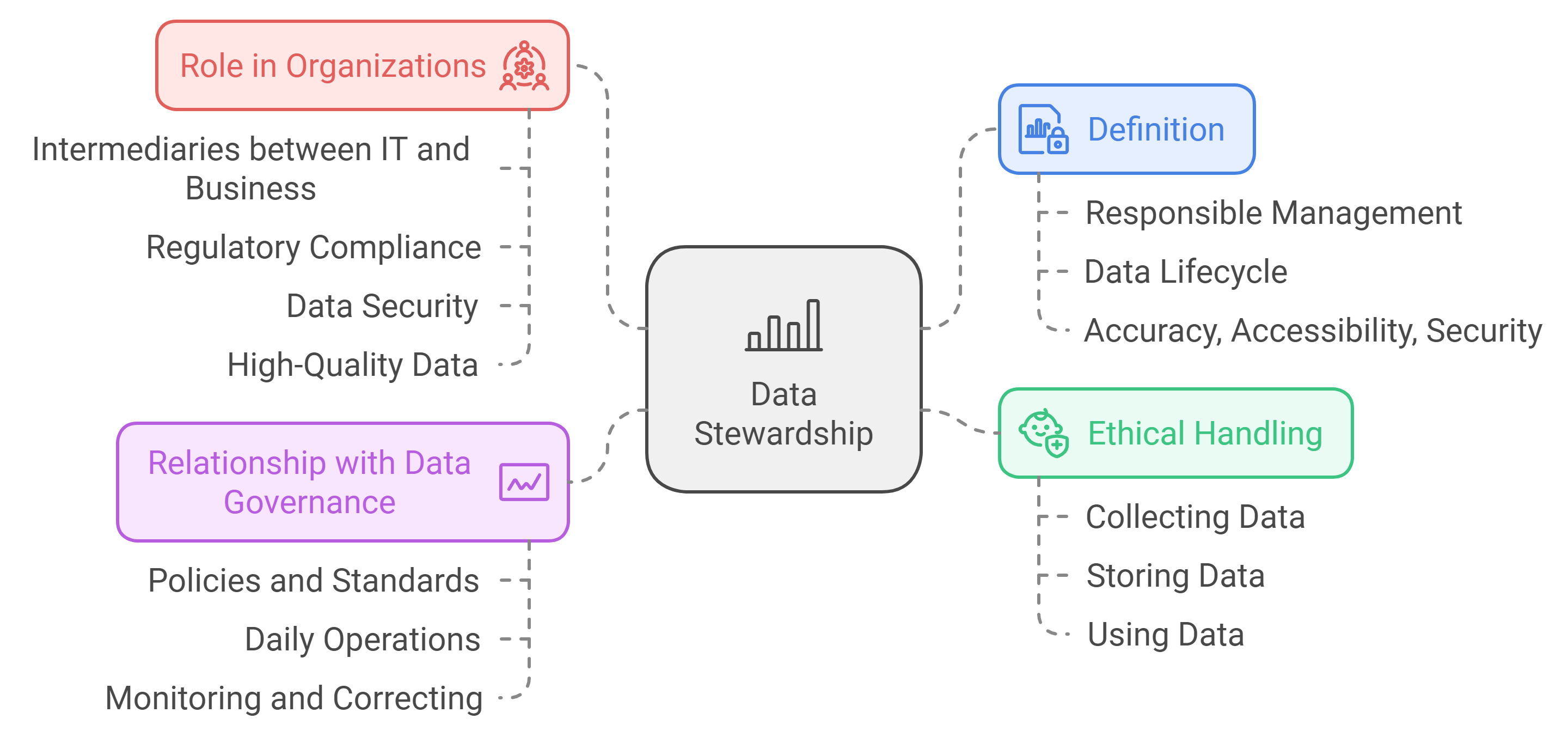
What Is Data Stewardship?
Data stewardship refers to the responsible management of data throughout its lifecycle. It ensures that data remains accurate, accessible, and secure while adhering to ethical and regulatory standards. You can think of it as the foundation for effective data governance. By focusing on the tactical aspects of data management, data stewardship guarantees that your organization’s data assets are reliable and trustworthy.
At its core, data stewardship emphasizes the ethical handling of data. This includes collecting, storing, and using data in ways that respect privacy and fairness. For example, when managing data that identifies individuals, data stewards ensure compliance with privacy laws and organizational policies. Their work safeguards sensitive information and builds trust with stakeholders.
The Relationship Between Data Stewardship and Data Governance
Data stewardship and data governance are closely connected, but they serve distinct purposes. Data governance establishes the overarching framework for managing data within your organization. It defines policies, standards, and procedures to ensure data aligns with your business objectives. Data stewardship, on the other hand, focuses on executing these policies in daily operations.
You can think of data stewardship as the operational arm of data governance. While governance sets the rules, stewardship ensures those rules are followed. For instance, if your organization has a policy to maintain data accuracy, data stewards take responsibility for monitoring and correcting inaccuracies. This relationship creates a seamless system where governance provides direction, and stewardship delivers results.
The Role of Data Stewards in Modern Organizations
In today’s data-driven world, data stewards play a critical role in your organization’s success. They act as intermediaries between IT teams and business units, ensuring that data management aligns with your goals. Their responsibilities go beyond technical tasks; they also foster collaboration and promote a culture of accountability.
Data stewards help you navigate complex challenges such as regulatory compliance and data security. They ensure that your data remains consistent across systems, making it easier for teams to access and use. By maintaining high-quality data, they empower you to make informed decisions and drive innovation. Their work not only supports operational efficiency but also strengthens your organization’s ability to compete in the market.
Key Responsibilities of Data Stewards
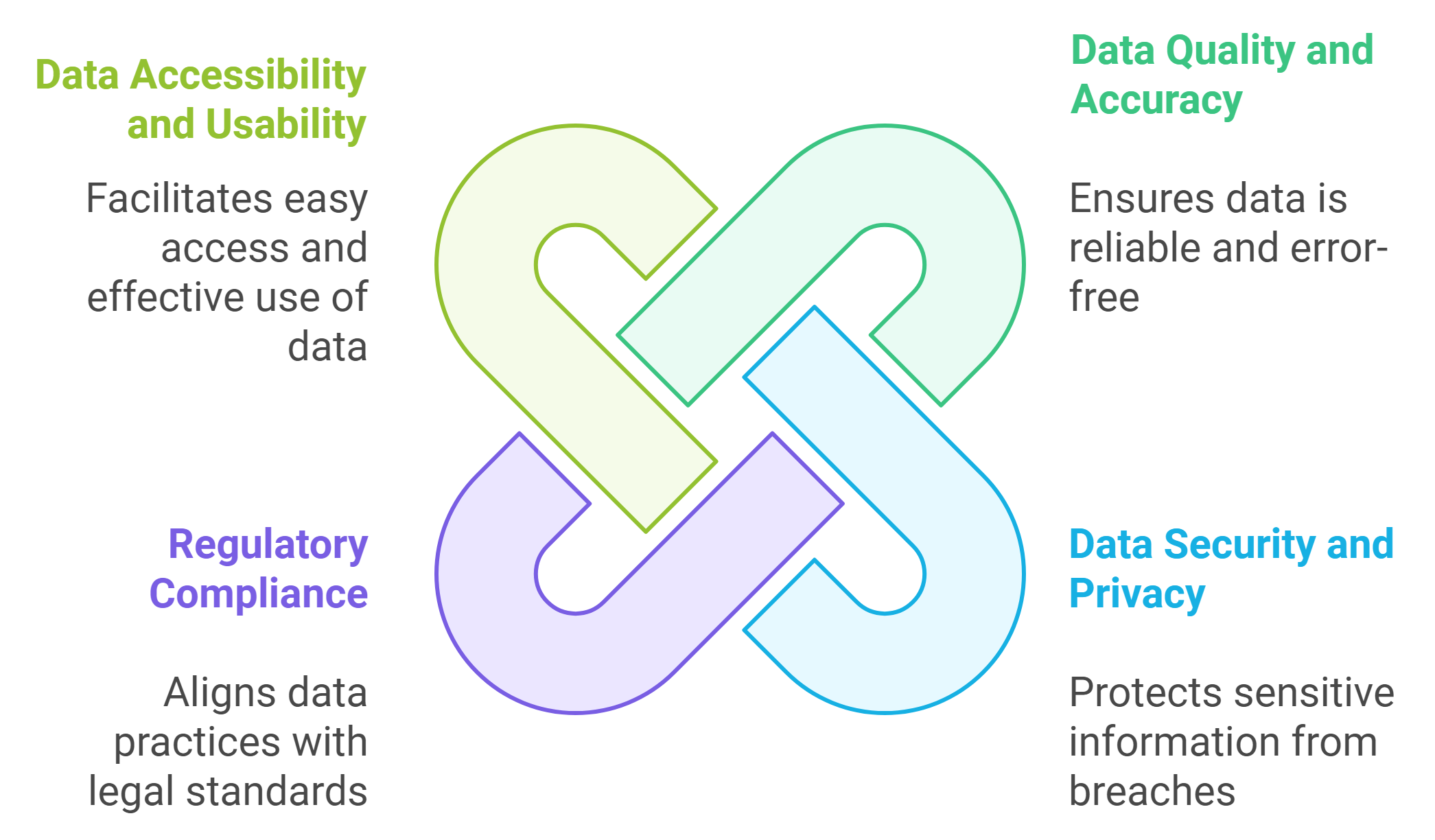
Ensuring Data Quality and Accuracy
Data stewards play a critical role in maintaining the quality and accuracy of your organization’s data. They actively monitor data to identify inconsistencies, errors, or outdated information. By implementing data quality metrics, they ensure that your data remains reliable and trustworthy. For example, they may establish standards for data entry to prevent errors at the source.
Their work doesn’t stop at identifying issues. Data stewards take corrective actions to resolve inaccuracies and maintain consistency across all data sources. This proactive approach minimizes risks associated with poor data quality, such as flawed decision-making or operational inefficiencies. Their efforts ensure that you can confidently rely on your data for strategic planning and business intelligence.
Maintaining Data Security and Privacy
In an era where data breaches and privacy violations dominate headlines, data stewards act as guardians of your sensitive information. They enforce security policies outlined by your organization’s data governance framework. This includes implementing access controls, monitoring data usage, and ensuring compliance with privacy laws like GDPR and CCPA.
Data stewards also educate your teams about best practices for data security. They promote awareness of potential risks and provide guidance on safeguarding sensitive information. By doing so, they create a culture of accountability and vigilance, reducing the likelihood of security incidents. Their work protects not only your data but also your organization’s reputation and stakeholder trust.
Driving Compliance with Regulatory Standards
Navigating complex regulatory environments requires expertise, and data stewards excel in this area. They interpret legal requirements and translate them into actionable policies for your organization. Whether it’s GDPR, HIPAA, or other regulations, data stewards ensure that your data management practices align with these standards.
Their responsibilities include overseeing adherence to governance policies and preparing for audits. By maintaining detailed records and documentation, they make the audit process smoother and more efficient. Their efforts help you avoid penalties and legal complications, ensuring that your organization remains compliant in an ever-evolving regulatory landscape.
Facilitating Data Accessibility and Usability
Data stewards play a vital role in ensuring that your organization’s data is both accessible and usable. They focus on breaking down barriers that prevent teams from leveraging data effectively. By doing so, they empower you to make informed decisions and foster a data-driven culture.
To enhance accessibility, data stewards implement systems and processes that allow authorized users to retrieve the data they need without unnecessary delays. They organize data in a structured manner, making it easier for you to locate and understand. For instance, they might create standardized naming conventions or metadata tags that simplify data searches. This ensures that your teams spend less time searching for information and more time analyzing it.
Usability is another critical area where data stewards excel. They ensure that data is presented in formats that align with your needs. Whether it’s dashboards, reports, or raw datasets, they tailor data delivery to suit different users. This customization helps you interpret data more effectively, leading to better insights and outcomes.
“Data stewards act as custodians, overseeing the proper handling, usage, and governance of data.”
This quote highlights their responsibility in ensuring data is managed effectively throughout its lifecycle.
Data stewards also collaborate with various departments to understand their unique requirements. By maintaining open communication, they identify gaps in data accessibility and usability. This proactive approach allows them to address issues before they become obstacles, ensuring seamless data operations across your organization.
In addition, they advocate for new tools and technologies that optimize data usage. For example, they might recommend implementing data visualization software to help you interpret complex datasets more easily. Their efforts not only improve your ability to access and use data but also enhance overall efficiency and productivity.
By facilitating data accessibility and usability, data stewards enable you to unlock the full potential of your data assets. Their work ensures that data becomes a valuable resource, driving innovation and supporting your organization’s success.
The Importance of Data Stewardship in Governance
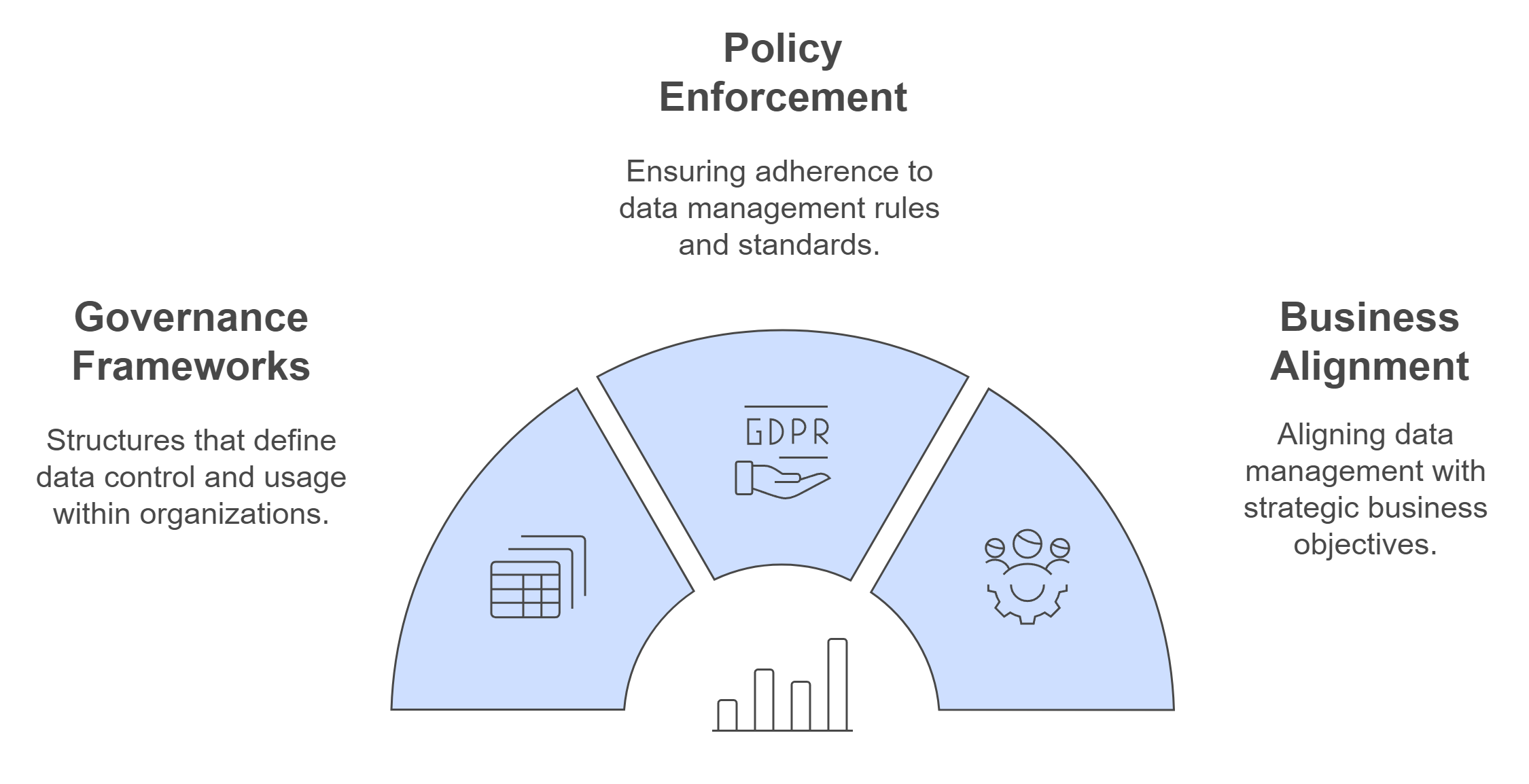
How Data Stewardship Enhances Governance Frameworks
Data stewardship strengthens governance frameworks by ensuring that data remains accurate, secure, and accessible. Governance frameworks define how data is controlled and used within your organization. Without proper execution, these frameworks lose their effectiveness. Data stewards act as the operational backbone, implementing governance policies in daily workflows.
By maintaining high-quality data, data stewards empower decision-makers to derive valuable insights. Reliable data allows you to identify trends, mitigate risks, and drive strategic initiatives. For example, when your organization needs to comply with regulatory requirements, data stewards ensure that all data processes align with those standards. This alignment enhances the overall governance framework, making it more robust and actionable.
“The symbiotic relationship between data stewardship and data governance is pivotal for organizations seeking to harness the full potential of their data assets.”
Investing in strong data stewardship practices ensures sustainable growth and innovation. It also provides a competitive advantage by enabling you to make informed decisions based on trustworthy data. This proactive approach transforms governance frameworks into dynamic systems that adapt to your evolving business needs.
The Role of Data Stewards in Policy Enforcement
Data stewards play a critical role in enforcing governance policies. They ensure that your organization adheres to established rules and standards for data management. This includes monitoring data usage, identifying policy violations, and taking corrective actions. Their vigilance helps you maintain compliance and avoid costly penalties.
Transparency is another key aspect of policy enforcement. Data stewards provide clear documentation and reporting, allowing stakeholders to understand how data is managed. This transparency builds trust and accountability within your organization. For instance, when preparing for audits, data stewards ensure that all records are accurate and up-to-date. Their efforts streamline the audit process and demonstrate your commitment to ethical data practices.
By acting as custodians of governance policies, data stewards create a culture of accountability. They educate teams about the importance of following data rules and provide guidance on best practices. This collaborative approach ensures that everyone in your organization understands their role in maintaining data integrity.
Aligning Data Stewardship with Business Objectives
Aligning data stewardship with your business objectives ensures that data management supports your strategic goals. Data stewards bridge the gap between IT and business units, translating technical policies into actionable steps that drive results. This alignment allows you to leverage data as a valuable asset for achieving success.
For example, if your goal is to improve customer satisfaction, data stewards ensure that customer data remains accurate and accessible. This enables your teams to analyze customer behavior and tailor services accordingly. Similarly, when launching new products, data stewards provide reliable market data to guide your decisions.
“Effective data governance and decision-making are crucial for promoting success and organizational improvement.”
Data stewards also facilitate collaboration across departments. By ensuring that data is consistent and usable, they enable teams to work together more effectively. This unified approach fosters innovation and helps you stay ahead in a competitive market. Their work not only supports operational efficiency but also aligns data management with your long-term vision.
Data Stewards and Data Quality
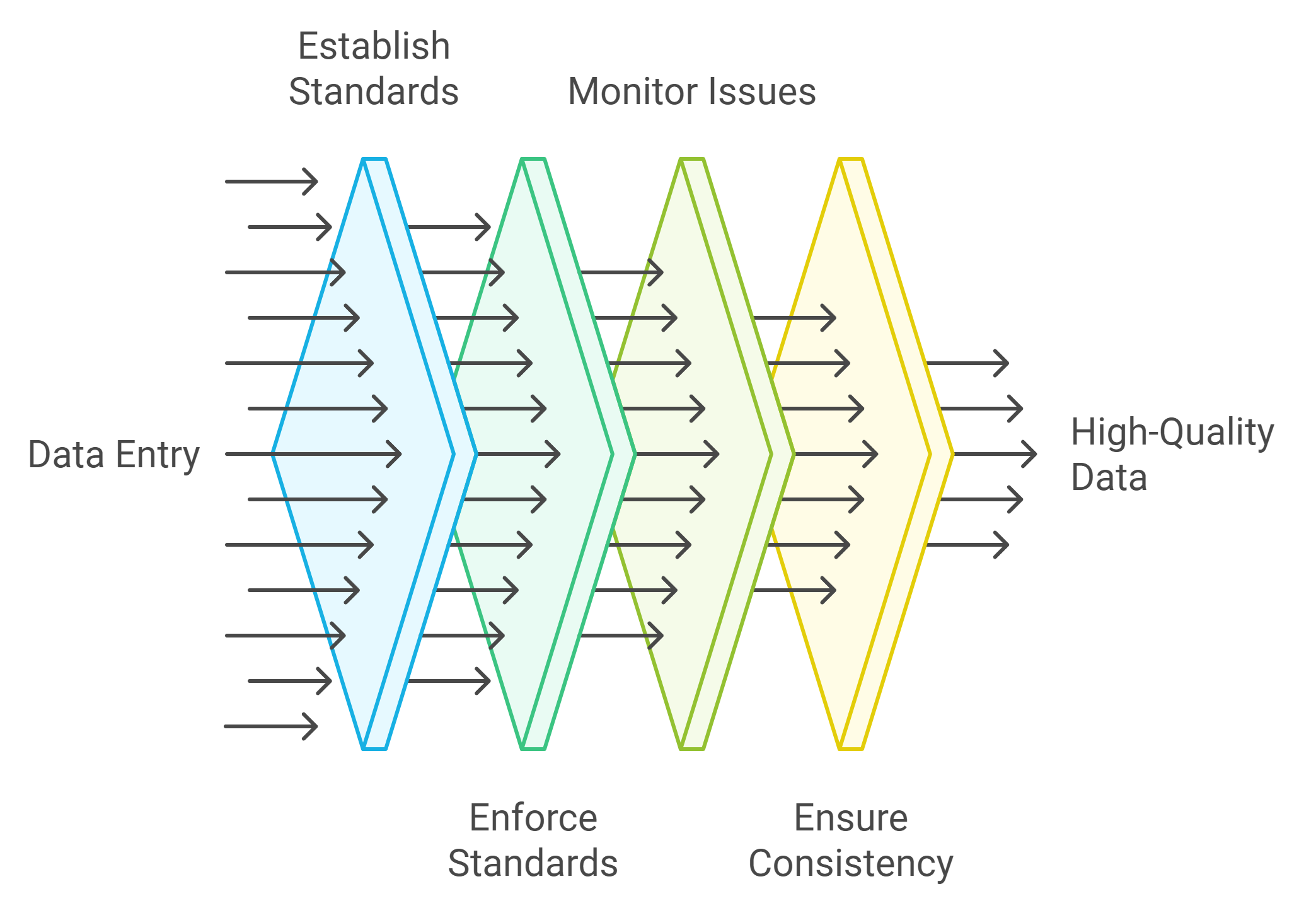
Establishing and Enforcing Data Quality Standards
You cannot achieve reliable decision-making without high-quality data. Data stewards take the lead in establishing and enforcing data quality standards to ensure your organization’s data remains accurate and dependable. They define clear benchmarks for data entry, storage, and usage, creating a foundation for consistency across all systems.
Data stewards also develop guidelines tailored to your organization’s needs. For example, they might implement rules for validating data during collection to minimize errors. These standards act as a safeguard, ensuring that every piece of data entering your system meets predefined quality criteria. By doing so, they help you avoid the pitfalls of poor data, such as flawed analytics or misguided strategies.
“Data stewardship focuses on tactical management of data assets to ensure quality, accessibility, and protection.”
Their role doesn’t stop at setting standards. Data stewards actively enforce these rules by monitoring compliance and addressing deviations. This hands-on approach ensures that your data remains aligned with organizational goals, enabling you to trust the information driving your decisions.
Monitoring and Resolving Data Quality Issues
Even with robust standards in place, data quality issues can arise. Data stewards play a crucial role in identifying and resolving these problems before they escalate. They continuously monitor your data for inconsistencies, inaccuracies, or gaps, using tools and techniques designed to detect anomalies.
When issues surface, data stewards act swiftly to address them. For instance, they might correct errors in customer records or reconcile discrepancies between datasets. Their proactive efforts prevent small problems from snowballing into larger challenges that could disrupt your operations.
Data stewards also document recurring issues to identify patterns and root causes. This analysis allows them to implement preventive measures, reducing the likelihood of future problems. By maintaining a vigilant approach, they ensure your data remains a reliable asset for your organization.
Ensuring Consistency Across Data Sources
In today’s interconnected world, your organization likely relies on multiple data sources. Ensuring consistency across these sources is essential for accurate analysis and reporting. Data stewards take responsibility for harmonizing data from different systems, creating a unified view that supports your decision-making.
They standardize formats, naming conventions, and metadata to eliminate discrepancies between datasets. For example, they might align customer information from various departments to ensure uniformity. This process not only improves data quality but also enhances collaboration across teams.
“Data stewardship implements rules to ensure compliance and improve data quality for better decision-making.”
Data stewards also establish processes for integrating new data sources seamlessly. By doing so, they help you adapt to changing business needs without compromising data integrity. Their work ensures that your organization can leverage its data effectively, regardless of its complexity or scale.
Data Stewards and Compliance
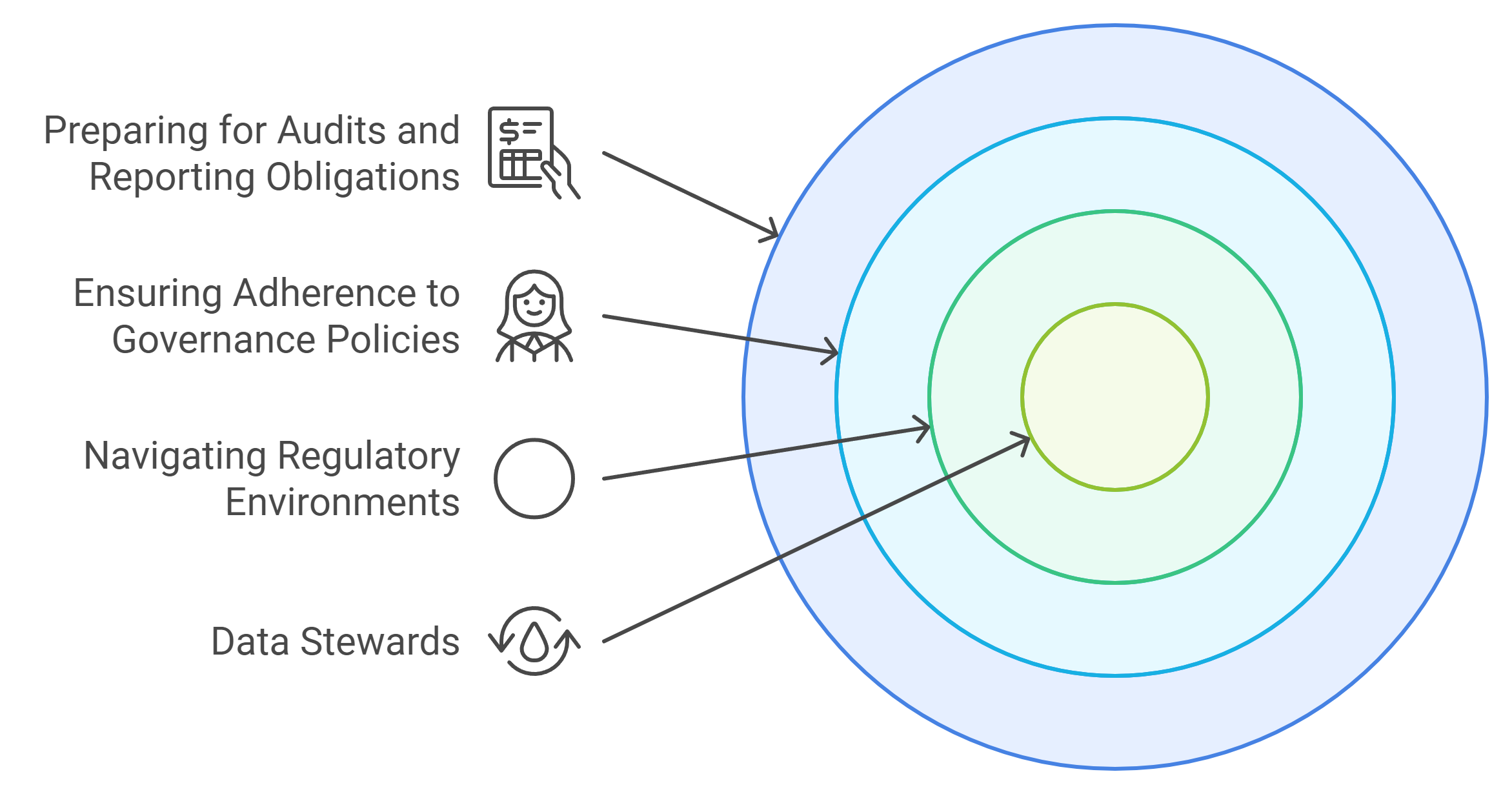
Navigating Complex Regulatory Environments
Regulatory environments grow more intricate every year. As a result, navigating these complexities becomes a critical task for your organization. Data stewards play a pivotal role in this process by ensuring your data practices align with legal requirements. They interpret regulations like GDPR, HIPAA, or CCPA and translate them into actionable steps for your teams.
Data stewards help you avoid costly penalties by proactively addressing compliance challenges. For instance, they ensure that sensitive data is stored securely and accessed only by authorized personnel. They also monitor changes in regulations and update your data policies accordingly. This vigilance keeps your organization ahead of potential compliance risks.
“Data stewards act as the first line of defense in ensuring compliance with ever-changing regulatory landscapes.”
By maintaining a clear understanding of legal obligations, data stewards simplify the complexities of regulatory environments. Their expertise ensures that your organization operates within the boundaries of the law, safeguarding both your reputation and financial stability.
Ensuring Adherence to Governance Policies
Governance policies provide the foundation for ethical and effective data management. However, these policies hold little value without proper enforcement. Data stewards ensure adherence by embedding governance rules into your daily operations. They monitor data usage, identify deviations, and take corrective actions when necessary.
For example, if your governance policy requires data accuracy, data stewards implement validation processes to catch errors during data entry. They also conduct regular audits to verify compliance with established standards. These efforts create a culture of accountability, where every team member understands the importance of following governance policies.
Data stewards also provide training and resources to help your teams comply with governance rules. They educate employees about best practices and the consequences of non-compliance. This proactive approach minimizes risks and ensures that your organization consistently meets its governance objectives.
Preparing for Audits and Reporting Obligations
Audits and reporting obligations can be daunting, but data stewards make the process manageable. They maintain detailed records of your data management activities, ensuring that all documentation is accurate and up-to-date. This preparation streamlines audits and demonstrates your commitment to compliance.
Data stewards also act as liaisons between your organization and auditors. They provide clear explanations of your data practices and address any concerns raised during the audit. Their involvement reduces the likelihood of misunderstandings and ensures a smooth audit process.
“Effective data stewardship transforms audits from a challenge into an opportunity to showcase your organization’s commitment to compliance.”
In addition to audits, data stewards handle reporting obligations by compiling and presenting data in a structured format. Whether it’s regulatory reports or internal performance reviews, they ensure that your data meets the required standards. Their work not only fulfills legal requirements but also enhances transparency and trust within your organization.
By navigating regulations, enforcing governance policies, and preparing for audits, data stewards play a crucial role in ensuring compliance. Their efforts protect your organization from legal risks and position you as a responsible and trustworthy entity in the eyes of stakeholders.
Data Stewards and Security
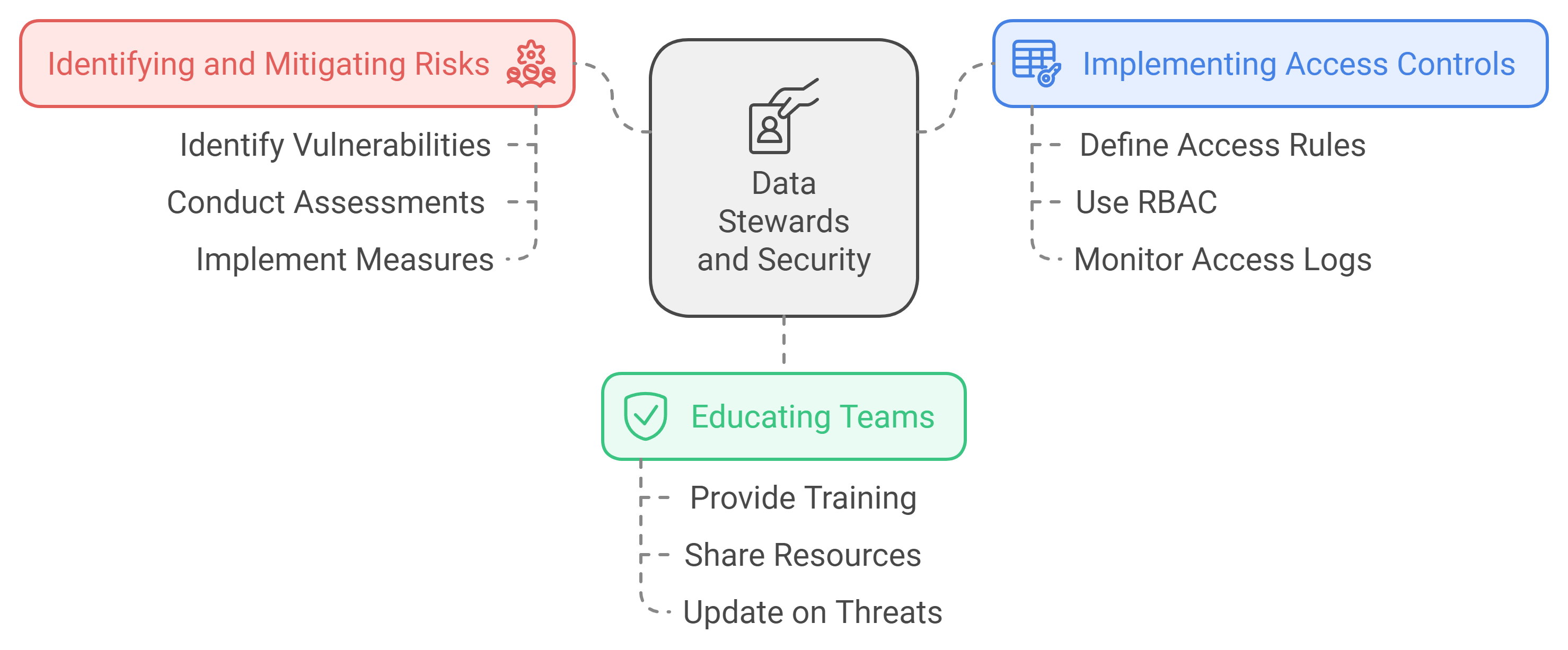
Identifying and Mitigating Data Security Risks
Data stewards play a vital role in protecting your organization from data security risks. They actively identify vulnerabilities that could expose sensitive information to unauthorized access or misuse. By conducting regular assessments, they uncover potential threats and implement measures to address them. For example, they might analyze system logs to detect unusual activity or evaluate third-party integrations for security gaps.
You benefit from their proactive approach to risk mitigation. Data stewards develop strategies to minimize the likelihood of breaches, such as encrypting sensitive data or isolating critical systems. They also ensure compliance with regulations like GDPR and CCPA, which require organizations to safeguard personal data. Their vigilance helps you avoid costly penalties and maintain trust with stakeholders.
“Data stewards act as the first line of defense in ensuring compliance with ever-changing regulatory landscapes.”
By identifying and mitigating risks, data stewards protect your organization’s reputation and ensure the integrity of your data assets.
Implementing Access Controls and Permissions
Controlling who can access your data is essential for maintaining security. Data stewards take charge of implementing robust access controls and permissions to prevent unauthorized use. They define clear rules about who can view, edit, or share specific datasets, ensuring that only authorized personnel have access.
For instance, they might use role-based access control (RBAC) to assign permissions based on job responsibilities. This approach limits exposure to sensitive information and reduces the risk of accidental or intentional misuse. Data stewards also monitor access logs to detect and respond to suspicious activity promptly.
Their work aligns with data governance policies, which emphasize accountability and responsibility. By enforcing strict access controls, data stewards help you comply with regulations like HIPAA, which mandates the protection of health information. Their efforts create a secure environment where your data remains protected from internal and external threats.
Educating Teams on Security Best Practices
Your team’s awareness of security best practices significantly impacts your organization’s ability to protect data. Data stewards take the lead in educating employees about safeguarding sensitive information. They provide training sessions, resources, and guidelines to ensure everyone understands their role in maintaining security.
For example, data stewards might teach your team how to recognize phishing attempts or create strong passwords. They also emphasize the importance of following organizational policies, such as encrypting files before sharing them. By fostering a culture of vigilance, they reduce the likelihood of human errors that could compromise security.
“Effective data stewardship transforms security from a technical challenge into a shared responsibility across the organization.”
Data stewards also stay updated on emerging threats and adapt their training programs accordingly. This ensures that your team remains prepared to handle new challenges in the ever-evolving landscape of data security. Their educational efforts empower you to build a resilient organization where security is a top priority.
The Impact of Data Stewardship on Organizational Success
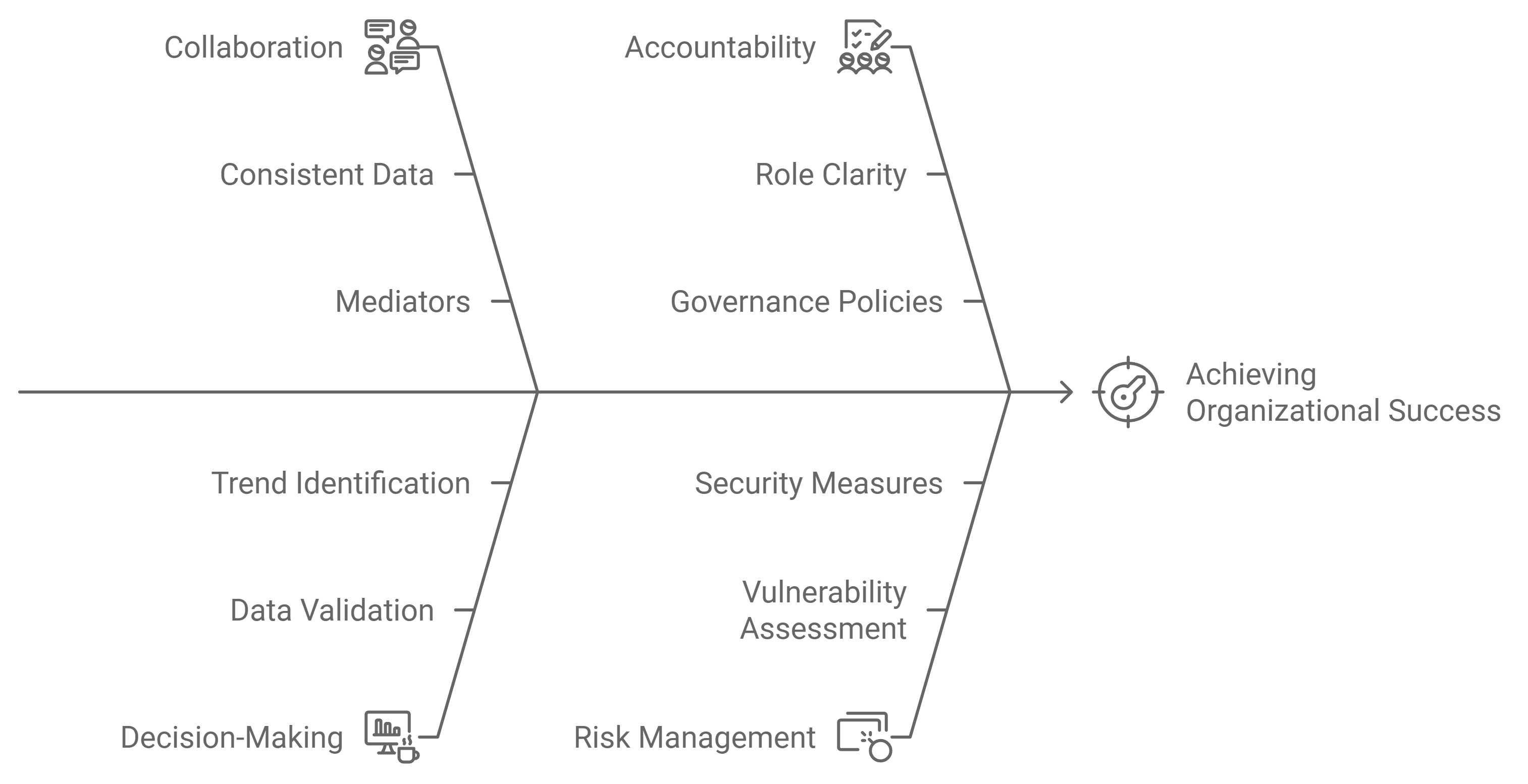
Enhancing Collaboration Across Departments
Data stewardship fosters collaboration by ensuring that all departments work with consistent and reliable data. When your teams access the same high-quality data, they can align their efforts and avoid misunderstandings. This shared foundation eliminates silos and promotes a unified approach to achieving organizational goals.
Data stewards act as mediators between departments. They facilitate communication by standardizing data formats and definitions, making it easier for everyone to interpret and use the information. For example, they might create a centralized data repository where all teams can access up-to-date records. This accessibility encourages cross-departmental projects and streamlines workflows.
“Collaboration thrives when data is accurate, accessible, and consistent across the organization.”
By breaking down barriers, data stewards enable your teams to share insights and innovate together. This collaborative environment not only improves efficiency but also drives creativity and problem-solving.
Supporting Data-Driven Decision-Making
Reliable data is the cornerstone of informed decision-making. Data stewards ensure that your organization’s data remains accurate, timely, and relevant. This reliability empowers you to make decisions based on facts rather than assumptions, reducing the risk of errors and missed opportunities.
Data stewards implement processes to validate and cleanse data, ensuring it meets business requirements. For instance, they might use automated tools to detect and correct errors in real-time. These efforts guarantee that the data you rely on for strategic planning is both trustworthy and actionable.
“High-quality data transforms decision-making from guesswork into a precise and confident process.”
By maintaining data integrity, data stewards help you identify trends, evaluate risks, and seize opportunities. Their work supports a culture where decisions are guided by evidence, leading to better outcomes and sustained success.
Promoting a Culture of Accountability and Ownership
Accountability begins with clear roles and responsibilities. Data stewards establish guidelines for data management, ensuring that everyone in your organization understands their part in maintaining data quality and security. This clarity fosters a sense of ownership, where each team member takes responsibility for their actions.
Data stewards also lead by example. They enforce governance policies and provide training to help your teams follow best practices. For instance, they might educate employees on the importance of protecting sensitive information or adhering to regulatory standards. This proactive approach creates a culture where accountability becomes second nature.
“When everyone takes ownership of data, the entire organization benefits from improved trust and efficiency.”
By promoting accountability, data stewards build a foundation of trust and reliability. This culture not only enhances your organization’s reputation but also strengthens its ability to adapt and thrive in a competitive landscape.
Reducing Risks Associated with Poor Data Management
Poor data management exposes your organization to significant risks, including data breaches, errors, and regulatory penalties. By prioritizing robust data stewardship practices, you can mitigate these risks effectively and safeguard your operations.
Data stewards play a pivotal role in identifying vulnerabilities within your data systems. They assess potential threats, such as unauthorized access or data misuse, and implement measures to address them. For instance, they establish access controls to ensure only authorized personnel can view or modify sensitive information. This approach minimizes the likelihood of data breaches and protects critical assets like personally identifiable information (PII), personal health information (PHI), and intellectual property (IP).
“Data stewards act as the first line of defense in mitigating risks associated with data breaches and improper use.”
To further reduce risks, data stewards enforce data validation and cleansing techniques. These methods ensure that your data remains accurate and consistent, preventing errors that could lead to flawed decision-making. For example, they might implement automated tools to detect and correct inconsistencies in real-time, ensuring your data meets business requirements.
Another critical aspect of risk reduction involves securing data against theft or tampering. Data stewards employ encryption, data masking, and other security measures to protect sensitive information. These practices not only fortify your organization’s security posture but also help you comply with regulations like GDPR and HIPAA, which mandate strict data protection standards.
Organizations also face risks from outdated or poorly maintained security protocols. Data stewards address this by establishing and regularly updating data security standards. They monitor emerging threats and adapt your security measures accordingly, ensuring your defenses remain robust in an ever-changing landscape.
By reducing risks associated with poor data management, you protect your organization from financial losses, reputational damage, and legal complications. Data stewards empower you to build a secure and reliable data environment, enabling you to focus on achieving your strategic goals with confidence.
How to Build an Effective Data Stewardship Program
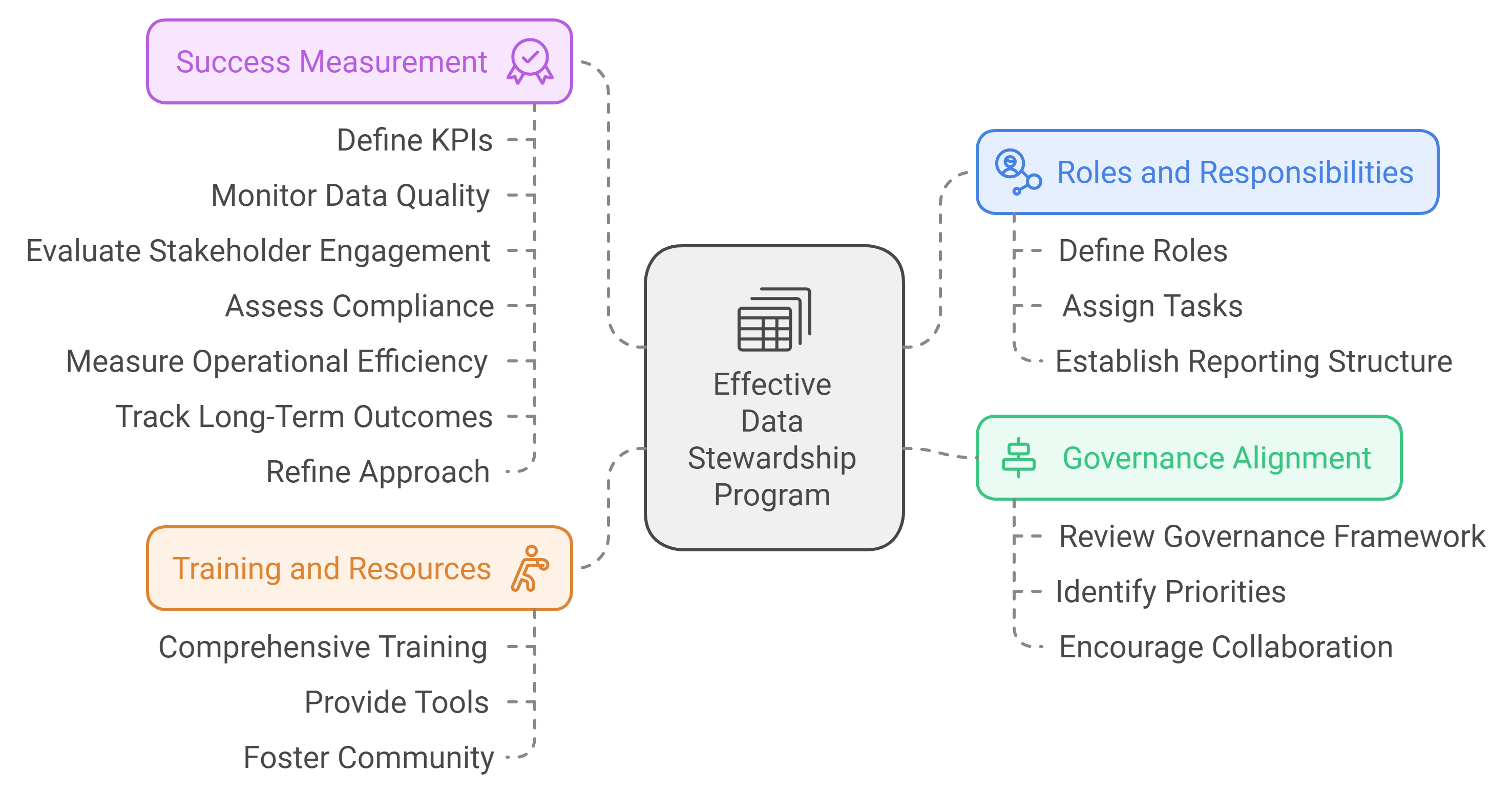
Establishing Clear Roles and Responsibilities
Building an effective data stewardship program begins with defining clear roles and responsibilities. You need to identify who will take ownership of specific data domains and ensure they understand their duties. Assigning these roles eliminates confusion and creates accountability within your organization.
Start by outlining the key tasks for data stewards. These include maintaining data quality, ensuring compliance, and facilitating accessibility. Each steward should know their specific area of focus, whether it’s customer data, financial records, or operational metrics. This clarity allows them to concentrate on their responsibilities without overlap or gaps.
“Data stewardship operates throughout the data lifecycle, from collection to analysis, ensuring responsible management at every stage.”
You should also establish a reporting structure. Data stewards must communicate with governance teams and business units to align their efforts with organizational goals. Regular check-ins and updates help maintain transparency and foster collaboration. By defining these roles and responsibilities, you create a strong foundation for your data stewardship program.
Aligning Data Stewardship with Governance Goals
To ensure success, your data stewardship program must align with your governance goals. Data stewardship acts as the operational arm of governance, so its activities should directly support your policies and objectives. This alignment ensures that your data management practices drive meaningful outcomes for your organization.
Begin by reviewing your governance framework. Identify the key priorities, such as regulatory compliance, data security, or operational efficiency. Then, tailor your data stewardship initiatives to address these areas. For example, if compliance is a top priority, your stewards should focus on monitoring adherence to legal standards and preparing for audits.
“Data stewardship strengthens governance frameworks by ensuring data remains accurate, secure, and accessible.”
Encourage collaboration between data stewards and governance teams. Regular meetings and shared goals help bridge the gap between strategy and execution. This partnership ensures that your stewardship program evolves alongside your governance framework, adapting to new challenges and opportunities.
Providing Training and Resources for Data Stewards
Empowering your data stewards with the right training and resources is essential for building an effective program. Without proper support, even the most skilled stewards may struggle to fulfill their responsibilities. Investing in their development ensures they can perform their roles with confidence and efficiency.
Start by offering comprehensive training programs. These should cover topics like data quality management, regulatory compliance, and security best practices. Hands-on workshops and real-world scenarios help stewards apply their knowledge effectively. You can also provide access to online courses and certifications to encourage continuous learning.
Equip your stewards with the tools they need to succeed. Data management software, analytics platforms, and security solutions streamline their workflows and enhance productivity. For example, tools that automate data validation or monitor compliance reduce manual effort and improve accuracy.
“A vibrant community of data stewards fosters collaboration, knowledge-sharing, and continuous improvement.”
Foster a sense of community among your stewards. Encourage them to share best practices, discuss challenges, and learn from one another. This collaborative environment not only enhances their skills but also strengthens your overall stewardship program.
By defining roles, aligning with governance goals, and providing robust training, you can build a data stewardship program that drives success. These steps ensure your organization manages its data responsibly and effectively, unlocking its full potential.
Measuring the Success of Data Stewardship Initiatives
Measuring the success of your data stewardship initiatives ensures that your efforts deliver tangible value to your organization. Without clear metrics, it becomes challenging to evaluate the effectiveness of your stewardship program or identify areas for improvement. By focusing on measurable outcomes, you can demonstrate the impact of data stewardship and refine your strategies for greater success.
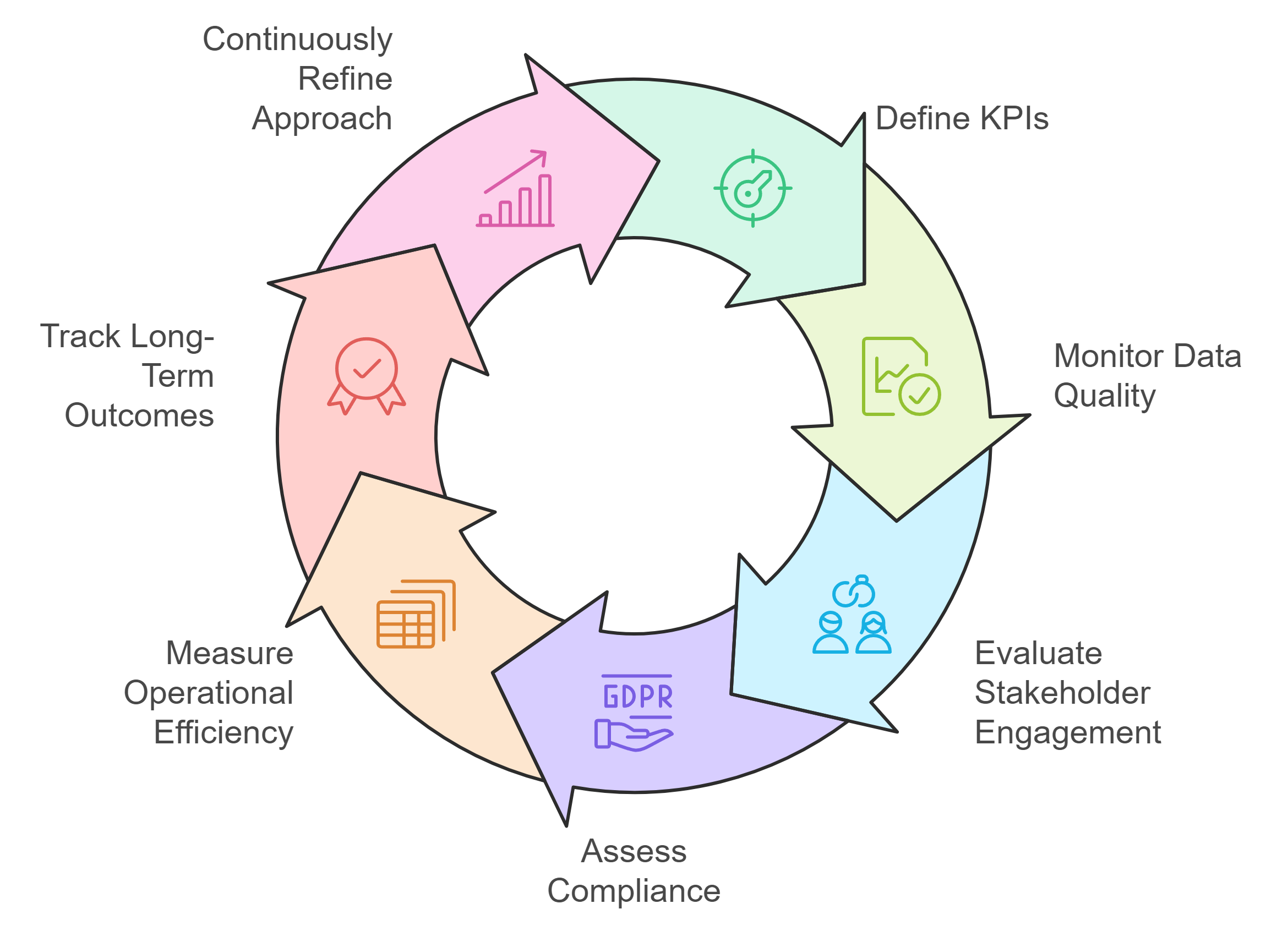
1. Define Key Performance Indicators (KPIs)
Start by identifying KPIs that align with your organization’s goals. These indicators should reflect the core responsibilities of data stewards, such as data quality, compliance, and accessibility. Examples of KPIs include:
Data accuracy rates: Measure the percentage of error-free data in your systems.
Compliance adherence: Track the number of successful audits or regulatory checks.
Data accessibility metrics: Evaluate how quickly teams can retrieve the data they need.
These KPIs provide a clear framework for assessing the performance of your data stewardship initiatives. They also help you communicate the value of stewardship to stakeholders.
“Data stewardship operates throughout the data lifecycle, ensuring responsible management at every stage.”
2. Monitor Data Quality Improvements
High-quality data is a cornerstone of effective decision-making. Regularly assess the improvements in data quality achieved through stewardship efforts. Use tools to monitor metrics like consistency, completeness, and timeliness. For instance, track the reduction in duplicate records or the increase in standardized data formats.
By documenting these improvements, you can showcase how data stewardship enhances the reliability of your organization’s data assets. This not only builds trust in your data but also highlights the critical role of stewards in maintaining data integrity.
3. Evaluate Stakeholder Engagement
Successful data stewardship fosters collaboration across departments and engages stakeholders in data management practices. Measure the level of participation in stewardship activities, such as training sessions or governance meetings. Assess how effectively data stewards facilitate communication between IT and business units.
A vibrant community of data stewards can drive knowledge-sharing and continuous improvement. Encourage feedback from stakeholders to identify gaps and refine your stewardship program. This engagement ensures that your initiatives remain relevant and impactful.
“A robust Data Stewardship Community fosters collaboration and drives effective governance initiatives.”
4. Assess Compliance and Risk Mitigation
Compliance with regulatory standards is a key objective of data stewardship. Track how well your organization adheres to governance policies and legal requirements. Monitor the frequency of compliance violations and the effectiveness of corrective actions taken by data stewards.
Additionally, evaluate the success of risk mitigation strategies implemented by stewards. For example, measure the reduction in data breaches or unauthorized access incidents. These metrics demonstrate how stewardship safeguards your organization’s data and reputation.
5. Measure Operational Efficiency
Data stewardship streamlines data management processes, leading to greater operational efficiency. Assess how stewardship initiatives reduce time spent on data-related tasks, such as data cleansing or error correction. Monitor the impact on productivity, such as faster decision-making or improved project timelines.
Operational efficiency metrics highlight the practical benefits of data stewardship. They also provide a compelling case for continued investment in stewardship programs.
6. Track Long-Term Outcomes
The ultimate goal of data stewardship is to support your organization’s success. Measure long-term outcomes, such as improved customer satisfaction, increased revenue, or enhanced innovation. Link these achievements to the contributions of data stewards, demonstrating their role in driving strategic objectives.
By tracking these outcomes, you can illustrate the broader impact of data stewardship on your organization. This reinforces the importance of stewardship as a critical component of your governance framework.
“Data stewards play a central role in creating partnerships and engaging communities in data access and use.”
7. Continuously Refine Your Approach
Measuring success is not a one-time activity. Regularly review your metrics and adjust your strategies based on the insights gained. Engage your data stewards in this process to ensure their efforts align with evolving organizational needs.
By continuously refining your approach, you can maximize the value of your data stewardship initiatives. This iterative process ensures that your program remains effective and adaptable in a dynamic business environment.
Measuring the success of data stewardship initiatives provides clarity and direction. It enables you to demonstrate the value of stewardship, optimize your efforts, and achieve sustainable success.
Data stewardship ensures your organization thrives by maintaining data quality, compliance, and security. Poor data quality costs companies an average of $12.9 million annually, highlighting the critical need for reliable data management. By prioritizing robust stewardship programs, you can avoid these losses and foster a data-driven culture. Empowering stewards with the right tools and resources enables them to align data practices with your goals. This approach unlocks the full potential of your data, driving informed decisions and sustainable success in an increasingly competitive landscape.
See Also
How Data Governance Enhances Overall Data Quality Standards
Understanding Data Governance: Key Principles and Best Practices
Incorporating Data Leadership Within Corporate Governance Frameworks
A Comprehensive Guide to Developing a Data Governance Plan
Essential Elements of Data Governance Featuring George Firican
